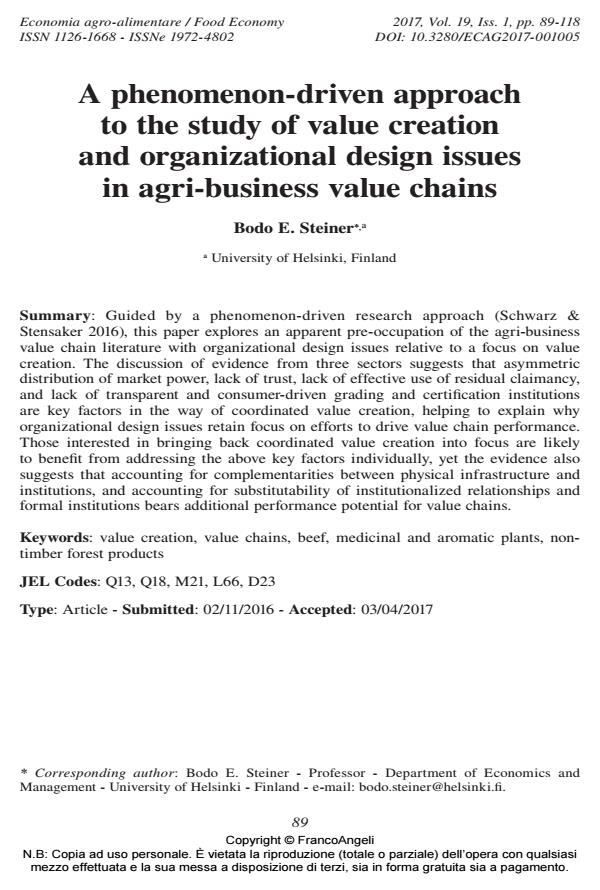A phenomenon-driven approach to the study of value creation and organizational design issues in agri-business value chains
Journal title ECONOMIA AGRO-ALIMENTARE
Author/s Bodo E. Steiner
Publishing Year 2017 Issue 2017/1
Language English Pages 30 P. 89-118 File size 206 KB
DOI 10.3280/ECAG2017-001005
DOI is like a bar code for intellectual property: to have more infomation
click here
Below, you can see the article first page
If you want to buy this article in PDF format, you can do it, following the instructions to buy download credits

FrancoAngeli is member of Publishers International Linking Association, Inc (PILA), a not-for-profit association which run the CrossRef service enabling links to and from online scholarly content.
Guided by a phenomenon-driven research approach (Schwarz & Stensaker 2016), this paper explores an apparent pre-occupation of the agri-business value chain literature with organizational design issues relative to a focus on value creation. The discussion of evidence from three sectors suggests that asymmetric distribution of market power, lack of trust, lack of effective use of residual claimancy, and lack of transparent and consumer-driven grading and certification institutions are key factors in the way of coordinated value creation, helping to explain why organizational design issues retain focus on efforts to drive value chain performance. Those interested in bringing back coordinated value creation into focus are likely to benefit from addressing the above key factors individually, yet the evidence also suggests that accounting for complementarities between physical infrastructure and institutions, and accounting for substitutability of institutionalized relationships and formal institutions bears additional performance potential for value chains.
Keywords: Value creation, value chains, beef, medicinal and aromatic plants, nontimber forest products
- Research approaches to sustainable forest-based value creation: A literature review Katri Rusanen, Teppo Hujala, Jouni Pykäläinen, in Forest Policy and Economics 103222/2024 pp.103222
DOI: 10.1016/j.forpol.2024.103222 - Transparency of sustainability disclosure in agri-food value chain management: Mapping the scientific landscape Bodo Steiner, Inna Makarenko, Kateryna Yuhai, in Problems and Perspectives in Management /2024 pp.268
DOI: 10.21511/ppm.22(4).2024.21 - The enabling and constraining connections between trust and digitalisation in incumbent value chains Kelly Rijswijk, Jasper R. de Vries, Laurens Klerkx, James A. Turner, in Technological Forecasting and Social Change 122175/2023 pp.122175
DOI: 10.1016/j.techfore.2022.122175 - The bargaining power, value capture, and export performance of Vietnamese manufacturers in global value chains Hanh Song Thi Pham, Bent Petersen, in International Business Review 101829/2021 pp.101829
DOI: 10.1016/j.ibusrev.2021.101829 - Toward a novel Sustainability Transparency Index for improved governance in agri-food value chains: A comparative study of Finnish and Ukrainian companies Inna Makarenko, Bodo Steiner, Kateryna Yuhai, in Accounting and Financial Control /2024 pp.68
DOI: 10.21511/afc.05(1).2024.06 - What enables metals ‘being’ ‘responsible’? An exploratory study on the enabling of organizational identity claims through a new sustainability standard Jean-Pierre Imbrogiano, Bodo Steiner, Renzo Mori Junior, Kathryn Sturman, in Resources Policy 103619/2023 pp.103619
DOI: 10.1016/j.resourpol.2023.103619 - Ecosystem for Successful Agriculture. Collaborative Approach as a Driver for Agricultural Development Nino Adamashvili, Mariantonietta Fiore, Francesco Contò, Piermichele La Sala, in European Countryside /2020 pp.242
DOI: 10.2478/euco-2020-0014 - Examining Value Generation activities in agro-industrial Chains: a Systematic literature Review Nathaly Albarracín Gutiérrez, Aura C Pedraza-Avella, Luis J López-Giraldo, in Ingeniería y Competitividad /2024
DOI: 10.25100/iyc.v26i2.14077
Bodo E. Steiner, A phenomenon-driven approach to the study of value creation and organizational design issues in agri-business value chains in "ECONOMIA AGRO-ALIMENTARE" 1/2017, pp 89-118, DOI: 10.3280/ECAG2017-001005